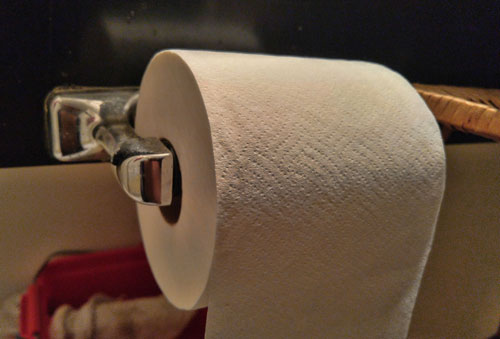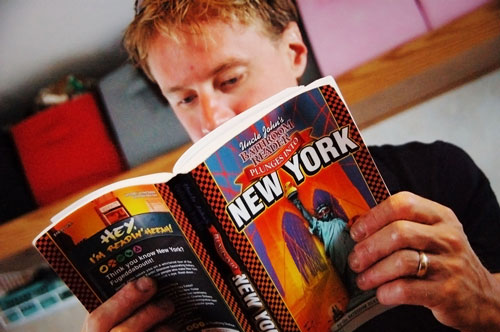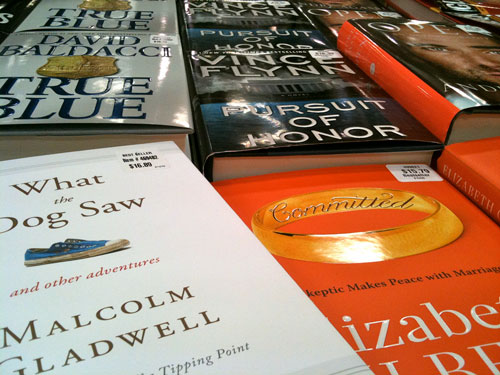Straight Flush
The story of Uncle John’s Bathroom Reader, the greatest book series of all time that targets a uniquely captive audience. The series turns 30 this year.
Hey guys, Ernie from Tedium here with a fresh piece from Andrew Egan, who wants to tell you all about a series of books that come in handy during a certain time of the day … uh, I’ll let him explain it. Thanks Andrew!
Today’s GIF comes from an episode of The Simpsons where Homer is weirded out by a talking Japanese toilet.
Sponsored By … You?
If you find weird or unusual topics like this super-fascinating, the best way to tell us is to give us a nod on Ko-Fi. It helps ensure that we can keep this machine moving, support outside writers, and bring on the tools to support our writing. (Also it’s heartening when someone chips in.)
63%
The percentage of people that read books, newspapers, or magazines in the bathroom, according to a survey by the plumbing-fixture company American Standard. It’s unlikely to be an exclusive habit as a similar survey found that 75 percent of people also use their phones while on the toilet. One Oregon resident realized the amount of time spent reading in the bathroom could be an interesting business opportunity.

There’s an actual Uncle John behind Uncle John’s Bathroom Reader
In 1987, John Javna was sitting on the toilet with nothing to read. Frustrated by the wasted time, Javna had an idea for a line of books based on the amount of time people spend in the bathroom. To actually write the books, he recruited his brother.
“John created it … based on the tradition that the whole family read a lot in the bathroom, and so did the whole world,” Gordon Javna told an Oregon newspaper in 2016. “I cracked up when I heard the idea from him, but it made a lot of sense.”
The first edition of the Uncle John’s Bathroom Reader, released in 1988, was a collection of short articles, like brief histories of various subjects and origins of words or phrases. Credited to the Bathroom Readers Institute, the books were a success. Sequels were released the following years until the brothers, along with a team of freelancers, were producing 10 titles a year.
In total, some 15 million copies have been sold.
A few quick hits from Uncle John’s Bathroom Reader
- Taking Care of the Lettuce Trivia: 80 percent of Canadians are happy with their hair.
- Ahead of His Time Trivia: Benjamin Franklin once wrote an essay pondering the possibility of waterskiing.
- That Was a Thing Trivia: Genesis Storytime was a cable network that displayed pages from children’s books for a few minutes before turning the page. It continued until the book was done. (Dibs on the Tedium article about this forgotten cable network!)
- That Can’t Be True Trivia: Half of people that are allergic to latex are also allergic to bananas.
- Heart-Warming Trivia: “Nikola Tesla read Mark Twain’s short stories as a sick, bedridden kid. Then, in 1888, Tesla met Twain and told him that his stories saved him as a child and ‘was amazed to see the great man of laughter burst into tears.’”

Modern Internet audiences will recognize the style employed by Uncle John’s
Uncle John’s Bathroom Reader completely leaned into its bathroom theme, employing toilet paper icons to number pages and organizing articles by “Short”, “Medium”, and “Large” length. And they’re not talking about the length of the articles.
Articles that make their way into Uncle John’s are usually non-fiction organized under a pun-based theme, such as “Court Transquips” followed by allegedly true humorous courtroom transcripts. According to their website, “Every article must be simple to read and every page must either have an amazing fact or a good laugh—or both.” When their work veers toward obscure subject matter, like “Forgotten TV Spin Offs”, the end result reads like countless blog articles or, ahem, newsletters.
Though a clear precursor to blog fodder, Uncle John’s worked well as a book, and its success made it a valuable commodity within the publishing world.
If you’re wondering how a book series like Uncle John’s could be so successful, a publishing scandal that rocked the industry in the early aughts shed some light on the weird world of publishing.
$43.3M
The amount of money owed to book publisher Random House by Advanced Marketing Services, a book distributor, who filed for bankruptcy protection in 2007 following an accounting scandal. One of the assets caught up in the wake was Uncle John’s Bathroom Reader.

Scenes from a Costco book section. (Rosa Say/Flickr)
When the accountants go rogue, everyone’s in trouble
As sales of physical books fell and bookstores closed, retailers followed by limiting shelf space. There was one retail category that still wanted books, if for no other reason than they simply ran out of products to offer their customers: Price clubs.
Costco, Sam’s Club, and other membership-based discount stores love to feature books on their sales floors. The New York Times explained the appeal in a 2007 article: “Books are a relatively small part of the price clubs’ total business, but they have one attribute that retailers love: the suggested retail price is printed directly on the book jacket. Because the books are then discounted by at least 20 or 30 percent, this promotes the feeling among buyers that the stores are offering them a bargain.”
To distribute books to price clubs, publishers turned to Advanced Marketing Services. The company was noted for “near-exclusive access” to the price clubs and became a primary driver of sales for some publishers. In a few instances, Advanced Marketing Services accounted for as much as ten percent of publishers’ book sales.
The company started expanding its portfolio to include titles that were successful in price clubs, like Uncle John’s Bathroom Reader. Gordon Javna himself noted the series’ popularity among discount shoppers, stating, “[Uncle John’s] became very popular all over the world, but an ironic thing was that Medford [Oregon] Costco was the best-selling outlet of any.”
But in 2003, an accounting scandal revealed a bevy of misconduct at the company. One executive pled guilty to conspiracy and wire fraud. In addition to overstating earnings, thus leading to higher bonuses and stock evaluations, management was also found bilking publishers with fake promotions and discounts.
The news rocked the industry, leaving some publishers owed eight-figure debts. Good Books, a speciality publisher of Amish and Mennonite books based in Intercourse, Pennsylvania, lost $1 million in the bankruptcy.
In the end, Uncle John’s continued operating with Gordon at the helm after John retired to care for their elderly parents. Gordon continued writing the series, along with his dutiful freelancers, until 2016 when its new owners decided to close the Uncle John’s office in Ashland, Oregon.
Uncle John’s continues today, releasing a 30th anniversary edition last fall, but the brothers’ involvement is less than clear.
Trivia books like Uncle John’s hold a special place in the hearts of anyone that aspired to appear on Jeopardy!. Their humor and unique attention to detail were a great use of the collective hours we spend answering nature’s call.
These collections of absurd non-fiction also inspired a new generation of writers to continue obsessing over technology, movies, and anything that might just be weird enough to be interesting. When pitching this story to Ernie, I asked him if he were comfortable comparing Tedium to Uncle John’s. Something like “Today’s Tedium takes a look at one of the giants whose shoulders we stand on.”
His reply: “You’ll find no complaints from me.”
:format(jpeg)/2018/03/tedium030618.gif)
/2018/03/tedium030618.gif)


/uploads/andrew_egan.jpg)